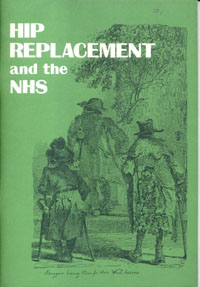Sign up to our newsletter Subscribe
Analysing Global Immunisation Expenditure

Of all forms of joint replacement operation, that for hips represents the most outstanding innovation. It is perhaps the major post-war surgical development and the key example of a technique which can radically improve quality of life at an acceptably low cost.
The…
Of all forms of joint replacement operation, that for hips represents the most outstanding innovation. It is perhaps the major post-war surgical development and the key example of a technique which can radically improve quality of life at an acceptably low cost.
The main indications are osteoarthritis (osteoarthrosis) and to a lesser extent rheumatoid arthritis. Since its introduction into common use in the 1960s total hip replacement has given, approaching 200,000 people in Britain, relief from the chronic pain and disability caused by these conditions. With the exception of abortion no other surgical procedure has increased in number so rapidly over the course of the seventies. In 1978, NHS hospitals in England and Wales provided an estimated 15,300 total hip replacements (or closely related partial hip replacements) for these diagnoses alone at the cost of some £18 million (ig8i prices).
It is upon these, usually elective, operations that this paper concentrates attention, focusing on issues of waiting time, criteria of acceptance for surgery and organisation of surgical resources. It also highlights the poverty of information available to clinicians and administrators for evaluating the services they provide.
The delivery of joint replacement, and in particular hip replacement, may be seen as an important indicator of the performance of the NHS generally. Much attention has been given recently to long waiting times. In-patient statistics, though 3 years out of date, show that average time on waiting lists was greater for elective arthroplasty than for any other operation, with 19 per cent of recipients in 1978 having waited one year or more. The equivalent figure for all surgery was six per cent. A partial explanation for this poor state of affairs has been pressure on orthopaedic resources from an increased incidence of fractured femurs among elderly people.
But for two reasons the prospects for the future may be considerably brighter than is sometimes feared. First, the rate of hip replacement may now be approaching a peak in some regions, even at quite low threshold levels of suitability for surgery. Certainly, data presented below seriously challenge the commonly held view that any feasible level of resources is capable of saturation by demand for replacement. Second, the very fact that throughput is so variable from region to region indicates that it could be substantially raised in many cases. The recent report of the DHSS Working Party on Orthopaedic Services confirms the potential for increased services within existing resources and goes on to suggest certain basic management techniques which could help to realise it. Clearly, much depends on the existence of conditions favouring a commitment by consultants and others to effective management of resources under their control.
The second most frequent replacement operation is arthroplasty of the knee. Approaching 3,000 were carried out in NHS hospitals in England and Wales in 1978. Fears have been expressed that because the prevalence of arthritic knees is considerably greater than arthritic hips, knee replacements may in the future impose even greater pressures on NHS resources. However, knee replacement is technically more difficult and the risk of failure is higher. In the absence of a major breakthrough, therefore, there is no immediate prospect that knees will ‘take off in the same way as hips did in the sixties and seventies. Nor is there any immediate likelihood of a burgeoning skeletal repair service for shoulders, ankles, wrists, finger joints and elbows, all of which have been successfully replaced in specialist centres.
Hip Replacement in the NHS
Laing, W. and Taylor, D.
(1982) Hip Replacement in the NHS. OHE Series on Health. Available from https://www.ohe.org/publications/hip-replacement-nhs/
